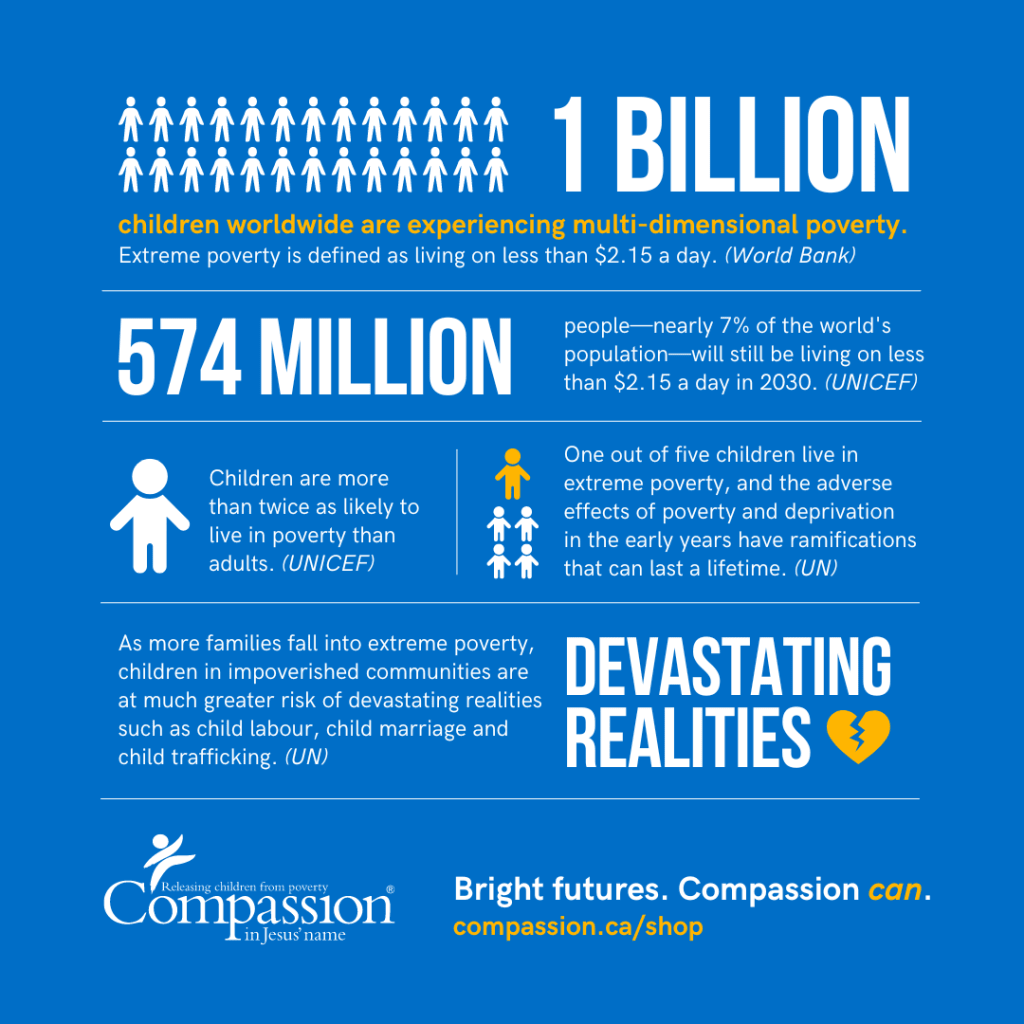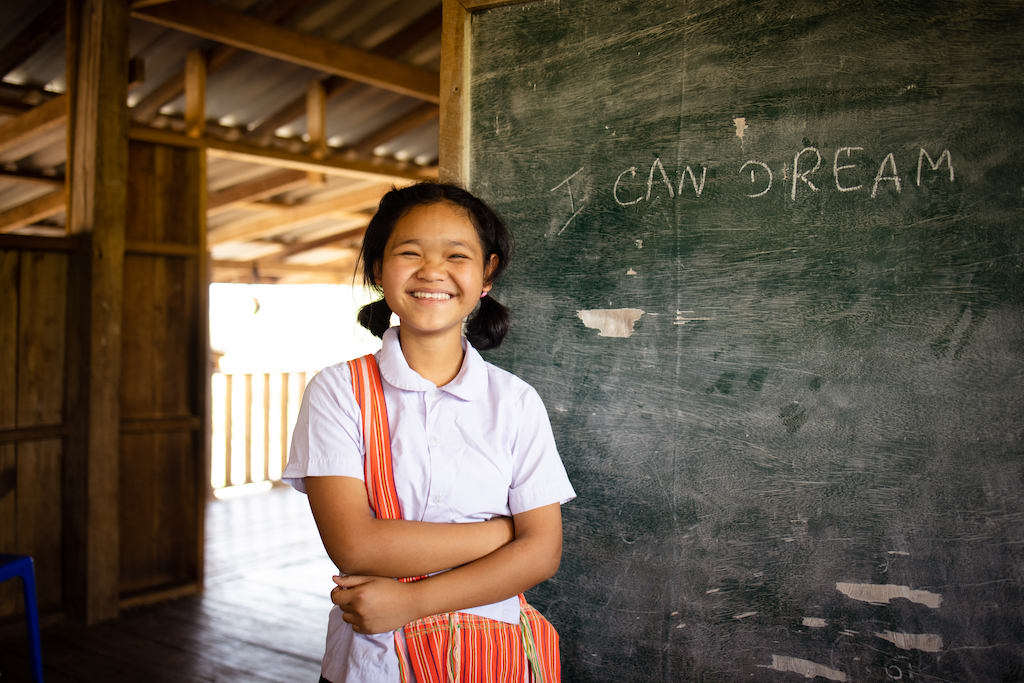You’ve heard the urgent message: One billion children worldwide are experiencing multi-dimensional poverty.
In 2024, child poverty is still rampant worldwide. We see the needs all around us—children experiencing poverty live without access to education, healthcare, housing, nutrition, sanitation, and water. Most importantly, poverty steals a child’s chance to dream.
We feel the burden of the needs. To meet these needs, we must address poverty’s multi-dimensional nature. We must invest in a child’s life holistically and meet their unique needs in relevant, agile and contemporary ways to truly break the cycle of poverty in their lives. By meeting these needs, we empower children to meet their incredible potential, leading to thriving families, communities and nations—generational transformation.
So, together we move with compassion. We feel the weight of this truth: the world needs good neighbours. Compassion is a global movement fuelled by the compassionate action of good neighbours like you. We must learn about the tools we have to impact our global neighbourhood with and how they can shape the way we move with compassion.
On this page:

Let’s start with some statistics.
It’s no secret that poverty is a complex problem. Extreme poverty is defined as living on less than $2.15 a day (World Bank). And given current trends, 574 million people—nearly 7 per cent of the world’s population—will still be living on less than $2.15 a day in 2030 (UNICEF).
Children are more than twice as likely to live in poverty than adults (UNICEF). Currently, one out of five children live in extreme poverty, and the adverse effects of poverty and deprivation in the early years have ramifications that can last a lifetime (UN).

As more families fall into extreme poverty, children in impoverished communities are at much greater risk of devastating realities such as child labour, child marriage and child trafficking (UN). Other consequences of poverty—hunger, homelessness, illness, lack of education—are significantly impacting children every day.
Statistics can tell us a lot about what the world is facing. Learning more about poverty and its impact on children can equip us to respond to their needs in a tangible way. Big numbers can be overwhelming, but they often catalyze life-changing action.

Learn how Compassion can change the statistics.
So, how do we respond to such a complex problem? Compassion.
Compassion is a powerful force that compels us to respond to the needs of the most vulnerable. Our compassion can move us to meaningful action, and when it is collective, our impact is multiplied.
We need good neighbours like you and those in your community to join the movement of compassion that is transforming the lives of children.
When you partner with Compassion, you are connected to the mission of releasing kids from poverty through practical tools and opportunities to move with compassion.
One of these tools is called Targeted Response. This term refers to specific strategic actions taken to meet the multi-dimensional needs of children in poverty. Though this term may not be familiar to you, you are probably familiar with what it looks like to engage with Targeted Response efforts:
It is that donation towards job training for women or a scholarship for a young student. It is the fundraiser for a water well for a community in desperate need of clean water. It’s the chicken, the computer, the dental kit or the meal for a family that meets the unique needs of a child or family. These actions are essential to caring for children and developing them holistically, both today and into the future.

We’re making an impact.
A move of compassion can have a transformative impact on someone else’s story. When we understand someone else’s story, we find ourselves seeing much more than statistics—we see people.
Take a moment to read these stories of compassion on the move. Each story focuses on a unique area of Compassion’s Targeted Response:
- Income Generation: Kids in El Salvador share the impact of a livestock gift
- Education and Training: The future is bright when kids in poverty get education
- Moms & Babies: Yenny learns how to make mattresses to support her family
- Safety and Stability: Read three stories of child protection in action
- Water and Sanitation: Egodine shares diary entries about receiving the gift of clean water
- Health and Wellness: Brian, Francis and Achille thrive after life-saving medical interventions
- Food and Hunger: Bobita doesn’t have to choose between food and her future
Stories are powerful tools for engaging with big realities. They remind us that taking action doesn’t mean solving the world’s problems in one moment. When we respond to a need, we can change the reality for one child, one family at a time.

Now’s the time to respond.
Now that you’ve learned about the multi-dimensional realities of children in poverty, you can move with compassion. Prayerfully consider how you can use your influence to make a difference.
1. Share
We need people like you to share this reality and invite others to respond. You can use your influence to inform others of what you’ve learned. Here are a few simple ways you can share:
a) One-on-one: Share a statistic you’ve learned, a story you’ve read or something that impacted you.
b) Small group: Share a video, read a story, host a discussion or walk through this Learn & Respond page together to engage more deeply.
c) Social media: Share an inspiring picture or video on Instagram, repost a Compassion blog on Facebook or Twitter or create your own post to encourage others to move with compassion on behalf of kids living in poverty.
2. Fundraise
We always need people who will raise funds so that tangible action can be taken to help feed and support children. You can use your influence to fundraise!
3. Pray
Wherever there is great need, we need people of prayer. You can use your influence by committing to pray with us for children living in poverty around the world.





